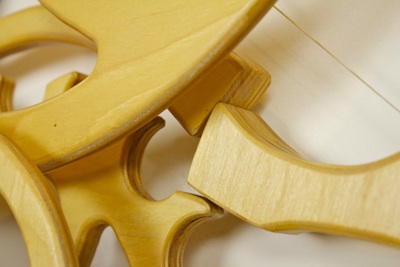Inventor Released is the second wall-mounted kinetic sculpture designed by David. He created it immediately following B.W. Cornwallis in the spring of 1976 (Link to post about B.W.) He recognized the inefficiencies in B. W. and was trying to improve upon them.

This sculpture, like its predecessor, is an escapement mechanism. Escapements have been used for centuries in clock making and can be used to measure regulated increments of time. David has always modified escapements, not worrying about their time keeping characteristics but instead working to maximize motion. It has allowed for a creative freedom that has always impacted his work. Compare the very visual motion in Inventor Release to the amount of motion you see in a clock.
In Inventor Released, David added an arm connected to the rotating wheel with a string. This allowed for some degree of adjustment by varying the string length. This is a great sculpture to study because it is one of the simplest and most revealing of David's designs. Basically, the weight is attached but can't descend because it is being held in place by the wooden ratchet. The pendulum wheel spins in one direction shortening the string and lifting the arm which causes the ratchet to release allowing the weight to drop just one notch before re- engaging.

The power from the release is transferred back through the arm giving it a needed push.

It now has enough energy to cause the main wheel to wind in the opposite direction, again shortening the string and again releasing the ratchet to repeat the process.
David's early pieces were all powered by descending weights. This is also similar to many early clocks. Inventor Released had the one descending weight and the higher you mounted the piece, the longer it would run. The limited factor was always that you needed to be able to reach the sculpture to wind it up again!
In the early years the inevitable question was, "Is it perpetual motion?" Clearly not. It requires the viewer to keep winding it up.
As you listen to the video you will hear the very loud and rhythmic click. David knew that a loud noise is the result of an inefficient mechanism. (It was also truly annoying to live with!). It was an effort to try and reduce the noise that kept David designing. A trend in David's work has always been that new designs evolved as he tried to solve things he didn't like about previous ones. Much inspiration came from his own work.
